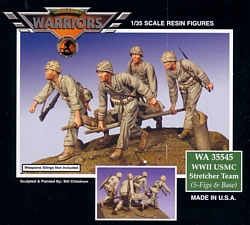| WWII
USMC Stretcher Team |
 |
|
This is one of sculptor Bill Chilstrom's finest productions. And it presents some unique challenges. First and foremost, though, is the incredible work Chilstrom has done with these figures. This quartet of Marines shows the strain of war and the weight of the buddy on the stretcher they are hauling. [REVIEWER'S NOTE: I will now refer to that particular piece of equipment by its proper name: litter.] Atop the provided small resin base that serves up a war-scarred landscape, the litter-bearers appear so real that they might run right off the terrain in search of Italeri's Dodge ambulance. All of the soldiers are dressed in the standard P1941 herring bone twill combat utilities, sleeves rolled up, shirt collars open, torn fabric at the knees and elbows. You can feel the heat of Guadalcanal, Tarawa, or Iwo Jima. Three of the four Marines wear the M1923 cartridge belt. The last figure has no ammo belt, however, the butt of a pistol protrudes from his shirt hip pocket, and he does carry an M1 Garand. He may be a medic corpsman. I don't know as much about Marine medics as I do about those in the Army, but I recall that medics were more of a target in the Pacific than in Europe. Consequently, they did arm themselves, and rarely did they wear the typical Red Cross on their helmet or sleeve. In any event, four M1 Garands are included, but you'll have to fashion your own slings out of lead foil, electrical tape, or paper. With the exception of the rifles and trench knives, no other gear is included; canteens and M12 trench gun ammo pouches are molded to the figures. The M1 helmets (molded to the heads as is Warriors' custom) are wrapped with camouflage covers. Again looking at the uniforms, Chilstrom has really captured both the slackness of the shirts and trousers, as well as the thinness of the fabric, with long, thin folds. The leg Apennines of the trousers are nicely hollowed out, even with the combat boots molded to the legs. The pockets are either bulging or sagging and gapped. And as mentioned, the uniforms are worn and torn. It all lends to the sense of movement, the knowing that these guys were actually living in these uniforms, rather than just dressed by them. The unfortunate soldier on the litter appears to have taken some nasty hits on the right side and left eye. His forearm is bandaged, his sleeve shredded. There is also a bandage around his upper thigh, and another Carlisle bandage over his left eye and wrapped around his head. The one little nitpick about this figure is that he measures around 5'6" while his handlers appear to be hitting 6', taking into account their crouching positions. Perhaps accentuated by his reclining position, the wounded soldier seems a bit puny. But maybe it's something that only someone who spent a long time studying the figures would notice. A problem with the litter is that it has no metal "feet" for it to be set on the ground or "scissors" arms for extending and collapsing it. These can be scratchbuilt with some snips of tin. My set of figure parts came jumbled in one single bag, rather than Warrior's usual practice of separate bags for each. So that meant carefully sorting through the arms to match them to the right bodies. Generally that's not a big deal, but since the arms need to be correctly placed in order to work with the litter, a mistake would be unfortunate. The small nubs at the upper ends of the arms that mesh with the shoulder sockets do not set the arms' angles, so gluing them a little too far forward or backward will also create a problem. And the mating surfaces themselves offer little help, unlike other figures where folds match between parts or there is a convex/concave relationship between the parts. Further compounding the challenge is the fact that the hands that carry the litter are molded onto the handles, which are separate from the litter. That means a more realistic grasp, which is good. Ultimately, what the modeler is faced with is trying to manage four attachment points to the litter that will create straight angles for the handles to the litter, keep the figures upright, and if you are using the base, working with eight contact points there as well. The base has no guiding outlines for placing the feet other than three pinholes surrounded by specks of smooth space. There are no corresponding pins on the bottoms of the combat boots, however. So the best was to approach this? I'm not sure yet, since I decided to hold off going any farther because I'd like to use this team in a diorama and want to set the figures to my particular groundscape. But I think I'll attach the figures to one side of the litter first, then to the other. It's clear, though, that some contour putty will be necessary where the wrists meet the bottoms of the bare forearms. The Pacific Theater has never held much interest for me. It's probably a cultural thing, being a white American male whose ancestors came from Northern Europe, as well as conditioning by films that are almost wholly focused on the fight against Germany. And frankly, having endured Minnesota winters for all of my nearly 50 years, I might just be more empathetic to the shivering hell of the northern climes than the sweltering hell of the Pacific. If the growing crop of Marine figures from Warriors (and Verlinden, to a lesser extent) made me curious, this set has really grabbed my attention. It looks like I'm going to have to open up a second front. -tss- |
 |
 |
 |
 |
 |
 |
 |
 |
 |
 |
 |
 |
|
 Warriors
Warriors